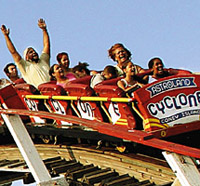New York's Cyclone roller coaster marks 80th anniversary
On a tranquil Coney Island morning, fragrant with salt water and last night's cotton candy, the silence is interrupted by the rapid-fire bursts of twin hammers beating against steel track.

Tucked 85 feet (25 meters) below, beneath the twists and turns of the Cyclone roller coaster, Gerry Menditto listens to the pounding with the intensity of a violin virtuoso tuning strings on a Stradivarius. "That hammer," he says evenly. "That will tell you what's happening."
As he has for 33 years, the white-haired Menditto is ensuring the venerable wood-and-steel coaster is running like a world-class sprinter before opening the attraction to hordes of screaming riders. On Tuesday, the legendary Cyclone - a paradise once nearly turned into a parking lot - celebrates its 80th birthday.
Menditto, 64, celebrated its 50th, 60th and 75th birthdays, too. He has became responsible for maintaining the national landmark.
"He's like an orchestra conductor," says Carol Albert, whose family has run the Cyclone since 1975. "He has such a sense of feel for that machine and what it's doing."
In the hours before the Cyclone rattles to life, Menditto and his staff give the red, white and blue coaster a complete once-over - from the wheels spinning beneath its vintage wooden cars to the tracks soaring above the Atlantic Ocean.
It's a routine going back generations, passed down among the coaster's blue-collar cognoscenti.
Menditto and his half-dozen workers arrive around 7 a.m. for their daily rounds, moving briskly before the beach and the boardwalk come to life. Broken bolts are removed and replaced, cracked wood quickly supplanted, fresh coats of paint smoothly applied.
But the work begins with the echoing hammers, wielded by two workers moving to the peculiar rhythms of their tools - step, swing, thwack!
Step, swing, thwack!
A less-than-robust response to the hammer means instant repair work. Track workers mark trouble spots with anything from a wiggly scratch in the steel to a baseball cap dropped beside a bad bolt.
Underneath the tracks, another worker tunes up the 100-horsepower motor that drives the Cyclone - the same one used when the coaster debuted on June 26, 1927.
It cost just a quarter then. Trans-Atlantic pilot Charles Lindbergh rode the Cyclone and proclaimed it was "greater than flying an airplane at top speed." And while a spin on the coaster left many speechless, it had the opposite effect on Emilio Franco.
Mute since birth, Franco uttered his first words after one ride on the Cyclone: "I'm sick!" The West Virginia coal miner, stunned by the sound of his own voice, then reportedly fainted.
With reviews like those, it was no surprise the Cyclone reigned for years as the city's No. 1 tourist attraction.
But the coaster, like the surrounding neighborhood, was in decline when Menditto first arrived. He worked in Coney Island as an electrician before answering the Cyclone's siren song in summer 1975.
"I came to refurbish the roller coaster for two weeks," he says. "By the third week, I was the manager."
What Coney Island will look like on its 81st birthday is anyone's guess. The neighboring Astroland amusement park is into its last season, and several other blocks are targeted for a $1.5 billion (euro1.1 billion) makeover aimed at turning the once-seedy strip into a glitzy year-round tourist attraction.
The Cyclone, thanks to its landmark status, will endure.
The 60 mph (97 kph) ride sounds almost quaint compared to new coasters, like the breathtaking Kingda Ka, which goes zero to 128 mph (205 kph) in 3.5 seconds and rises 45 stories up. But Menditto knows his ride offers more than any 21st-century scream machines.
"It's a legend in its own time," he says. "Everybody knows about it."
Although he's spent half his life with the Cyclone, he has never spent one second aboard the ride.
"I've never been on the Cyclone in my life," Menditto says. "I'm not afraid of heights. I just don't like the drop."
Subscribe to Pravda.Ru Telegram channel, Facebook, RSS!




